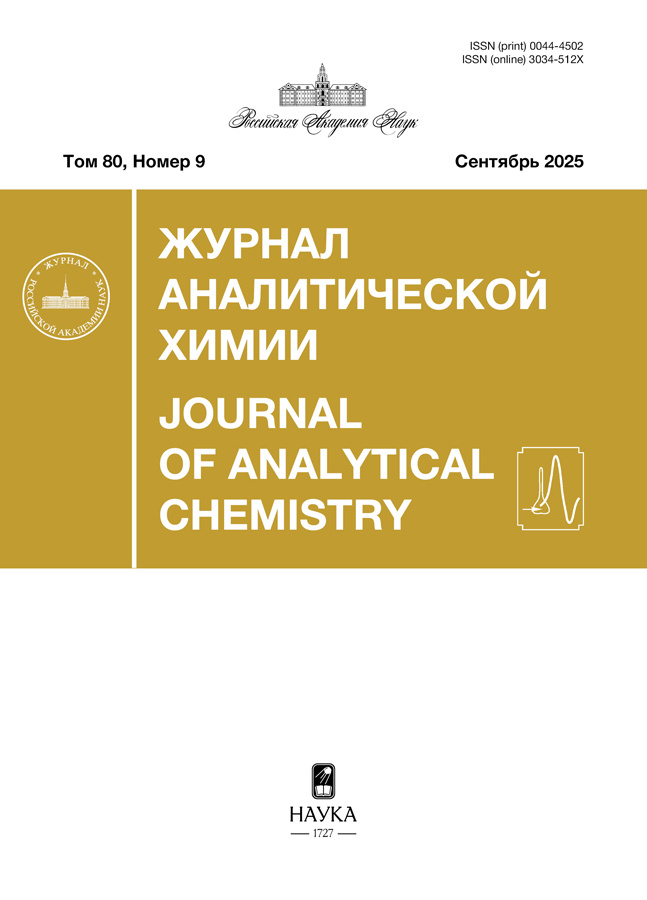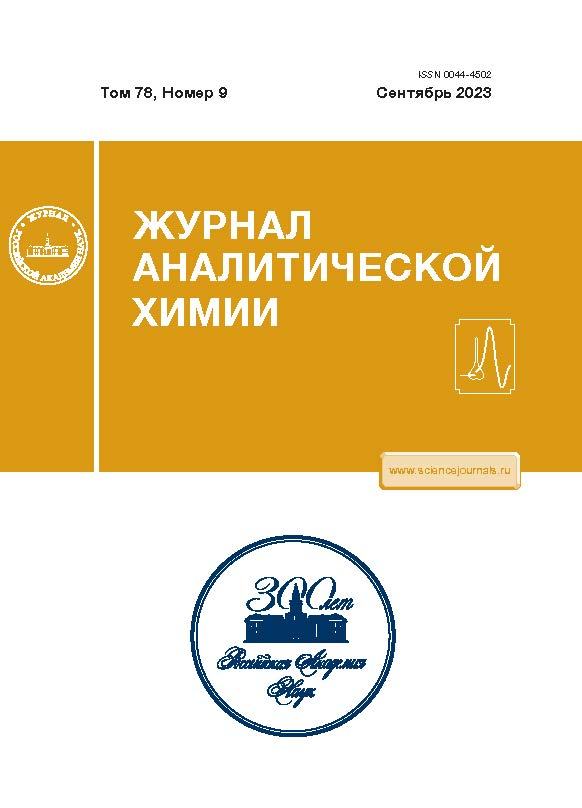Селективные сорбенты на основе импринтированной глюкооксидазы
- Авторы: Пиденко П.С.1, Пресняков К.Ю.1, Дрозд Д.Д.1, Бурмистрова Н.А.1
-
Учреждения:
- Саратовский государственный университет им. Н.Г. Чернышевского, Институт химии
- Выпуск: Том 78, № 9 (2023)
- Страницы: 807-812
- Раздел: ОРИГИНАЛЬНЫЕ СТАТЬИ
- Статья получена: 31.01.2025
- URL: https://cardiosomatics.ru/0044-4502/article/view/650109
- DOI: https://doi.org/10.31857/S0044450223090104
- EDN: https://elibrary.ru/ZXCFYJ
- ID: 650109
Цитировать
Полный текст
Аннотация
Разработана методика синтеза высокоселективного сорбента на основе импринтированного белка (ИБ) – глюкооксидазы (ГО) – и коммерчески доступных микрочастиц SiO2 для сорбции микотоксина зеараленона, продуцируемого грибами вида Fusarium. Впервые предложено использование 3D флуоресцентной спектроскопии для контроля процесса очистки ИБ. Оценена возможность замены молекулы зеараленона в качестве молекулы шаблона на структурные аналоги, обладающие более низкой токсичностью. Определены аналитические характеристики определения зеараленона с использованием импринтированной ГО в качестве рецепторного элемента в иммуноферментном анализе: предел обнаружения – 5 нг/мл, линейный диапазон определяемых концентраций – 11–112 нг/мл. Показаны высокие сорбционные характеристики синтезированного сорбента на основе ИБ (сорбционная емкость – 7.6 мкг/мг сорбента, импринтинг фактор – 2.5).
Об авторах
П. С. Пиденко
Саратовский государственный университет им. Н.Г. Чернышевского, Институт химии
Email: naburmistrova@mail.ru
Россия, 410012, Саратов, ул. Астраханская, 83
К. Ю. Пресняков
Саратовский государственный университет им. Н.Г. Чернышевского, Институт химии
Email: naburmistrova@mail.ru
Россия, 410012, Саратов, ул. Астраханская, 83
Д. Д. Дрозд
Саратовский государственный университет им. Н.Г. Чернышевского, Институт химии
Email: naburmistrova@mail.ru
Россия, 410012, Саратов, ул. Астраханская, 83
Н. А. Бурмистрова
Саратовский государственный университет им. Н.Г. Чернышевского, Институт химии
Автор, ответственный за переписку.
Email: naburmistrova@mail.ru
Россия, 410012, Саратов, ул. Астраханская, 83
Список литературы
- Mahato D.K., Devi S., Pandhi S., Sharma B., Maurya K.K., Mishra S., Dhawan K., Selvakumar R., Kamle M., Mishra A.K., Kumar P. Occurrence, impact on agriculture, human health, and management strategies of zearalenone in food and feed: A review // Toxins. 2021. V. 13. № 2. P. 92. https://doi.org/10.3390/toxins13020092
- Haque M.A., Wang Y., Shen Z., Li X., Saleemi M.K., He C. Mycotoxin contamination and control strategy in human, domestic animal and poultry: A review // Microb. Pathog. 2020. V. 142. Article 104095. https://doi.org/10.1016/j.micpath.2020.104095
- Gupta R.C., Mostrom M.S., Evans T.J. Zearalenone / Veterinary Toxicology. Elsevier, 2018. P. 1055. https://doi.org/10.1016/B978-0-12-811410-0.00076-3
- Taranu I., Braicu C., Marin D.E., Pistol G.C., Motiu M., Balacescu L., Beridan Neagoe I., Burlacu R. Exposure to zearalenone mycotoxin alters in vitro porcine intestinal epithelial cells by differential gene expression // Toxicol. Lett. 2015. V. 232. № 1. P. 310. https://doi.org/10.1016/j.toxlet.2014.10.022
- Технический регламент таможенного союза “О безопасности зерна” (ТР ТС 015/2011). clck.ru/33utzE (дата обращения 30.03.2023).
- Единые санитарно-эпидемиологические и гигиенические требования к продукции (товарам), подлежащей санитарно-эпидемиологическому надзору (контролю). clck.ru/33uu2q (дата обращения 30.03.2023).
- E. U. Commission Regulation (EC) No 1126/2007 of 28 September 2007 amending Regulation (EC) No 1881/2006 setting maximum levels for certain contaminants in foodstuffs as regards Fusarium toxins in maize and maize products, 2007. clck.ru/33vPwZ (дата обращения 30.03.2023).
- Fleck S.C., Hildebrand A.A., Müller E., Pfeiffer E., Metzler M. Genotoxicity and inactivation of catechol metabolites of the mycotoxin zearalenone // Mycotoxin Res. 2012. V. 28. № 4. P. 267. https://doi.org/10.1007/s12550-012-0143-x
- Moreau M., Lescure G., Agoulon A., Svinareff P., Orange N., Feuilloley M. Application of the pulsed light technology to mycotoxin degradation and inactivation: Destruction of mycotoxins by pulsed light // J. Appl. Toxicol. 2013. V. 33. № 5. P. 357. https://doi.org/10.1002/jat.1749
- Loi M., Fanelli F., Liuzzi V., Logrieco A., Mulè G. Mycotoxin biotransformation by native and commercial enzymes: Present and future perspectives // Toxins. 2017. V. 9. № 4. P. 111. https://doi.org/10.3390/toxins9040111
- Lucci P., David S., Conchione C., Milani A., Moret S., Pacetti D., Conte, L. Molecularly imprinted polymer as selective sorbent for the extraction of zearalenone in edible vegetable oils // Foods. 2020. V. 9. № 10. P. 1439. https://doi.org/10.3390/foods9101439
- Gutierrez A.V.R., Hedström M., Mattiasson B. Bioimprinting as a tool for the detection of aflatoxin B1 using a capacitive biosensor // Biotechnol. Reports. 2016. V. 11. P. 12. https://doi.org/10.1016/j.btre.2016.05.006
- Pidenko P., Zhang H., Lenain P., Goryacheva I., De Saeger S., Beloglazova N. Imprinted proteins as a receptor for detection of zearalenone // Anal. Chim. Acta. 2018. V. 1040. P. 99. https://doi.org/10.1016/j.aca.2018.07.062
- Beloglazova N., Lenain P., Tessier M., Goryacheva I., Hens Z., De Saeger S. Bioimprinting for multiplex luminescent detection of deoxynivalenol and zearalenone // Talanta. 2019. V. 192. P. 169. https://doi.org/10.1016/j.talanta.2018.09.042
- Pidenko P., Presnyakov K., Beloglazova N., Burmistrova N. Imprinted proteins for determination of ovalbumin // Anal. Bioanal. Chem. 2022. V. 414. № 18. P. 5609. https://doi.org/10.1007/s00216-022-04009-3
- Liu J., Zhang K., Ren X., Luo G., Shen J. Bioimprinted protein exhibits glutathione peroxidase activity // Anal. Chim. Acta. 2004. V. 504. № 1. P. 185. https://doi.org/10.1016/S0003-2670(03)00763-3
- Burmistrova N.A., Pidenko P.S., Pidenko S.A., Zacharevich A.M., Skibina Y.S., Beloglazova N.V., Goryacheva I.Y. Soft glass multi-channel capillaries as a platform for bioimprinting // Talanta. 2020. V. 208. Article 120445. https://doi.org/10.1016/j.talanta.2019.120445
- Sánchez D.A., Alnoch R.C., Tonetto G.M., Krieger N., Ferreira M.L. Immobilization and bioimprinting strategies to enhance the performance in organic medium of the metagenomic lipase LipC12 // J. Biotechnol. 2021. V. 342. P. 13. https://doi.org/10.1016/j.jbiotec.2021.09.022
- Li B., Duan D., Wang J., Li H., Zhang X., Zhao B. Improving phospholipase D activity and selectivity by bio-imprinting-immobilization to produce phosphatidylglycerol // J. Biotechnol. 2018. V. 281. P. 67. https://doi.org/10.1016/j.jbiotec.2018.06.343
- Li K., Wang J., He Y., Cui G., Abdulrazaq M.A., Yan Y. Enhancing enzyme activity and enantioselectivity of Burkholderia cepacia lipase via immobilization on melamine-glutaraldehyde dendrimer modified magnetic nanoparticles // Chem. Eng. J. 2018. V. 351. P. 258. https://doi.org/10.1016/j.cej.2018.06.086
- Haskell A.K., Sulman A.M., Golikova E.P., Stein B.D., Pink M., Morgan D.G., Lakina N.V., Karpenkov A.Yu., Tkachenko O.P., Sulman E.M., Matveeva V.G., Bronstein L.M. Glucose oxidase immobilized on magnetic zirconia: Controlling catalytic performance and stability // ACS Omega. 2020. V. 5. № 21. P. 12329. https://doi.org/10.1021/acsomega.0c01067
- Drozd D.D., Pidenko P.S., Presnyakov K.Y., Strokin P.D., Speranskaya E.S., Goryacheva I.Y. Dihydrolipoic acid coated alloyed quantum dots / Saratov Fall Meeting 2019: Optical and Nano-Technologies for Biology and Medicine / Eds. Tuchin V.V., Genina E.A. 2020. V. 1145714. https://doi.org/10.1117/12.2564393
- Mahdizadeh F., Eskandarian M. Glucose oxidase and catalase co-immobilization on biosynthesized nanoporous SiO2 for removal of dissolved oxygen in water: Corrosion controlling of boilers // J. Ind. Eng. Chem. 2014. V. 20. № 4. P. 2378. https://doi.org/10.1016/j.jiec.2013.10.016
- Zhou G., Fung K.K., Wong L.W., Chen Y., Renneberg R., Yang S. Immobilization of glucose oxidase on rod-like and vesicle-like mesoporous silica for enhancing current responses of glucose biosensors // Talanta. 2011. V. 84. № 3. P. 659. https://doi.org/10.1016/j.talanta.2011.01.058
- Tamer U., Seçkin A.İ., Temur E., Torul H. Fabrication of biosensor based on polyaniline/gold nanorod composite // Int. J. Electrochem. 2011. V. 2011. P. 1. https://doi.org/10.4061/2011/869742
- Cai W., Li H.-H., Lu Z.-X., Collinson M.M. Bacteria assisted protein imprinting in sol–gel derived films // Analyst. 2018. V. 143. № 2. P. 555. https://doi.org/10.1039/C7AN01509G
- Sakamoto S., Minami K., Nuntawong P., Yusakul G., Putalun W., Tanaka H., Fujii S., Morimoto S. Bioimprinting as a receptor for detection of kwakhurin // Biomolecules. 2022. V. 12. № 8. P. 1064. https://doi.org/10.3390/biom12081064
- Ayadi C., Anene A., Kalfat R., Chevalier Y., Hbaieb S. Molecularly imprinted polyaniline on silica support for the selective adsorption of benzophenone-4 from aqueous media // Colloids Surf. A: Physicochem. Eng. Aspects. 2019. V. 567. 2019. P. 32. https://doi.org/10.1016/j.colsurfa.2019.01.042
- Janati-Fard F., Housaindokht M.R., Monhemi H. Investigation of structural stability and enzymatic activity of glucose oxidase and its subunits // J. Mol. Catal. B: Enzym. 2016. V. 134. P. 16. https://doi.org/10.1016/j.molcatb.2016.09.008
- Drozd D.D., Byzova N.A., Pidenko P.S., Tsyupka D.V., Strokin P.D., Goryacheva O.A., Zherdev A.V., Goryacheva I.Yu., Dzantiev B.B. Luminescent alloyed quantum dots for turn-off enzyme-based assay // Anal. Bioanal. Chem. 2022. V. 414. № 15. P. 4471. https://doi.org/10.1007/s00216-022-04016-4
- Nakamura S., Fujiki S. Comparative studies on the glucose oxidases of Aspergillus Niger and Penicillium amagasakiense // J. Biochem. 1968. V. 63. № 1. P. 51. https://doi.org/10.1093/oxfordjournals.jbchem.a128747
- Yiu H.H.P., Wright P.A. Enzymes supported on ordered mesoporous solids: A special case of an inorganic–organic hybrid // J. Mater. Chem. 2005. V. 15. № 35–36. P. 3690. https://doi.org/10.1039/b506090g
Дополнительные файлы
















